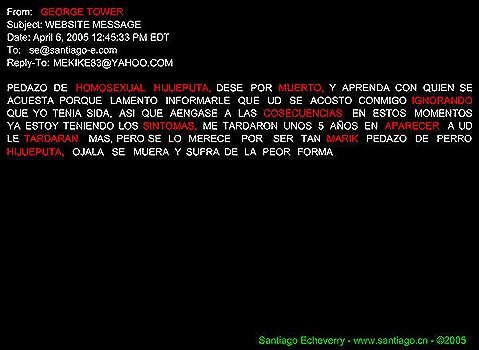Banco de la Republica de Colombia,
Sep 05, 2007 - Mar 05, 2008
Bogota, Colombia
Net Art in Colombia: It's Ugly and Doesn't like the Cursor
by Eduardo Navas
Violence, which has been part of Colombia for decades due to drug trafficking as well as instabilities in the governmental and educational systems, is by no means absent in this exhibition. Devis has chosen polemical works that touch on the harsh reality that Colombia currently lives. Two projects that stand out for their audacity and blunt acknowledgment of ignorance and indifference as major cultural problems are Sida/ Aids (2005) by Santiago Echeverry, and Death 30 Times (Muerte en Treinta Tiempos) (2007) by Claudia Salamanca. Sida/Aids consists of an e-mail received by the artist in which he was told that he contracted Aids when he had sex with a man supposedly named George Tower. The e-mail informs Echeverry that he got what he deserves and that he should think twice before going to bed with others. The animation takes key terms from the e-mail message, which, when the user mouses-over, reveal other words that contradict or complement the content. The end result is a psychological play on the hate mail, which can be read as a commentary on the necessity to educate people about Aids. Death 30 Times remixes video footage of the Mayor of the City of Roble who made a plea to the President of Colombia, ílvaro Uribe. The Mayor was given 30 seconds to talk about education, but, instead, he chose to declare publicly that he had received a death threat. Apparently, nothing was done about this, and thirty days later the Mayor was killed. Salamanca takes a structural approach and remixes the thirty seconds into thirty sections in her two video remixes. As Devis notes, it is peculiar that it was also thirty days later that the Mayor was killed. This video is a direct commentary on the politics of Colombia -and the indifference that is at play in the government. One has to wonder why nothing was apparently done to protect the Mayor, based on the argument posed by Salamanca.
Perhaps the most striking realization of the exhibition is the fact that some of the participants are not necessarily artists. Projects like Bogowiki, and Radio Fantasmas do not depend on the art institution for validation. And as Devis himself acknowledges in his essay, artists such as Tupac Cruz, who developed, Vallenato Tántrico, which consists of a series of animations meant to be remixed live for an audience, did not expect to be included in an art exhibition at all.
Along these lines of crossing over to unexpected paradigms we encounter the last category "Play With Me," in which the current aesthetics of gaming, mainly driven by consumer and entertainment culture, are active. Only in this case, the works are not actual video games. An example is Play With Me (2004) by Rafael Puyana. In his project the user can manipulate different parts of a male figure. One can change the color of the eyes, hair, as well as his sweater. Gaming is questioned here due to the simplicity of the interface: there is no point other than to explore how far one can manipulate the subject and because of the limitation of interactivity, one inevitably questions the point of the project, and of gaming, itself. Another example within these lines is Sonidos y Energías [Sounds and Energies] (2003) by Santiago Ortiz. Here, the same principle of playing with simple objects are in effect as well, only the objects no longer resemble a person, but platonic solids, or simple geometrical shapes, which are manipulated to create soundscapes. Some of the projects by Ortiz resemble mixing consoles, which the user can manipulate to create ephemeral music compositions. Overall, many of the interfaces developed by Ortiz feel like testing grounds for more complex interfaces. And this allows the user to become aware of the building blocks necessary to create gaming environments like Second Life.
Other gaming projects included in the exhibition are overtly political. Tácticas de guerra irregular [Tactics of Irregular War] (2004) by Juan Ospina González AKA Piter Wilson, for example, uses the language of gaming to comment critically on the violence in Colombia. Being aware of the abstraction provided by games like Backgammon, Checkers, Chess as well as card games, the artist decided to create an interface in which the users, if they are to play to win, must participate in scenarios simulating massacres, kidnappings and cold murders.
|











